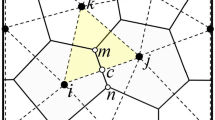Abstract
A modified Voronoi cell finite element method is proposed to allow for fluid pressure within porous materials. Traction on the hole boundary can equal the force generated by the pressure, and multiplying the Lagrange multiplier by the constraints, we derive a new function. The stiffness matrix and load vector were derived from the modified element energy functional. Numerical examples with various boundary problems were evaluated using the proposed model and compared with a conventional displacement-based finite element model. The results show that the proposed method can measure the irregular local stress on porous materials that contain randomly distributed and sized holes with specifics pressures. The proposed method significantly reduces the number of elements and nodes of the calculated porous structure.














Similar content being viewed by others
References
Allaire, G.: Homogenization of the Stokes ow in a connected porous medium. Asymptot. Anal. 2(3), 203–222 (1989)
Brown, D.L., Efendiev, Y., Hoang, V.H.: An effcient hierarchical multiscale finite element method for Stokes equations in slowly varying media. Multiscale Model. Simul. 11(1), 30–58 (2013)
Christenson, R.M., Lo, K.H.: Solutions for effective shear properties in three phase sphere and cylinder models. J. Mech. Phys. Solids 27(4), 315–330 (1979)
Feireisl, E., Lu, Y.: Homogenization of stationary Navier–Stokes equations in domains with tiny holes. J. Math. Fluid Mech. 17(2), 381–392 (2015)
Ghosh, S., Moorthy, S.: Particle fracture simulation in non-uniform microstructures of metal-matrix composites. Acta Metall. et Mater. 46(3), 965–982 (1998)
Guo, R., Shi, H.J., Yao, Z.H.: The modeling of interfacial debonding crack in particlereinforced composites using Voronoi cell finite element method. Comput. Mech. 32(1–2), 52–59 (2003)
Guo, R., Shi, H.J., Yao, Z.H.: Numerical simulation of thermo-mechanical fatigue propertiesfor particulate reinforced composites. Acta Mech. Sin. 21(2), 160–168 (2005)
Li, S., Ghosh, S.: Modeling interfacial debonding and matrix cracking in fiber reinforced composites by the extended Voronoi cell fem. Finite Elem. Anal. Des. 43(5), 397–410 (2007)
Lo, D.C., Allen, D.H.: Modeling of delamination damage evolution on laminated composites subjected to low velocity impact. Int. J. Damage 3, 378–407 (1994)
Marusic-Paloka, E., Mikelic, A.: An error estimate for correctors in the homogenization of the Stokes and Navier–Stokes equations in a porous medium. Boll. Unione Mat. Ital. 10(3), 661–671 (1996)
Moorthy, S., Ghosh, S.: Model for analysis of arbitrary composite and porous microstructures with voronoi cell finite elements. Int. J. Numer. Methods Eng. 39(14), 2363–2398 (1996)
Moorthy, S., Ghosh, S.: Adaptivity and convergence in the Voronoi cell finite element model for analyzing heterogeneous materials. Comput. Methods Appl. Mech. Eng. 185(1), 37–74 (2000)
Qiang, Xu, Chen, Jian-yun: Study on the element with the hole and crack. Acta Mech. 25(7), 1915–1930 (2014)
Sandstr om, C., Larsson, F., Runesson, K., Johansson, H.: A two-scale_finite element formulation of Stokes ow in porous media. Comput. Methods Appl. Mech. Eng. 261(262), 96–104 (2013)
Zhang, G.J., Guo, R.: Interfacial cracks analysis of functionally graded materials using Voronoi cell finite element method. Proced. Eng. 31, 1125–1130 (2012)
Acknowledgements
This work was supported by the National Natural Science Foundation of China (Grant No. 11402103 and Grant No.11572142).
Author information
Authors and Affiliations
Corresponding author
Rights and permissions
About this article
Cite this article
Zhang, R., Guo, R. Voronoi Cell Finite Element Method for Fluid-Filled Materials. Transp Porous Med 120, 23–35 (2017). https://doi.org/10.1007/s11242-017-0898-9
Received:
Accepted:
Published:
Issue Date:
DOI: https://doi.org/10.1007/s11242-017-0898-9




